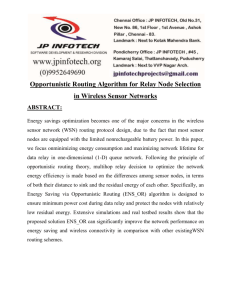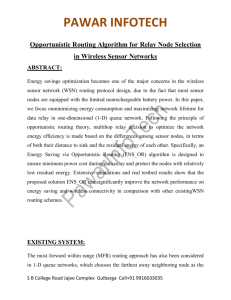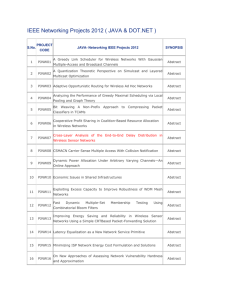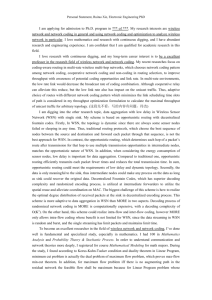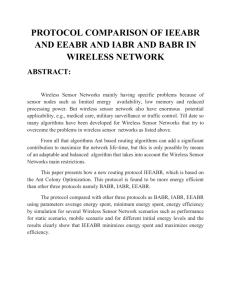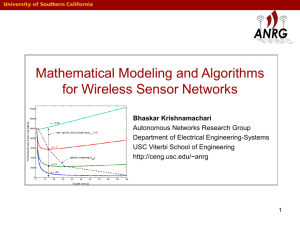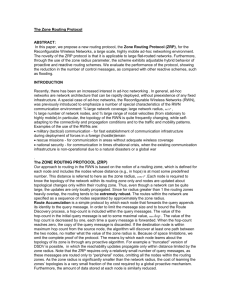existing system
advertisement
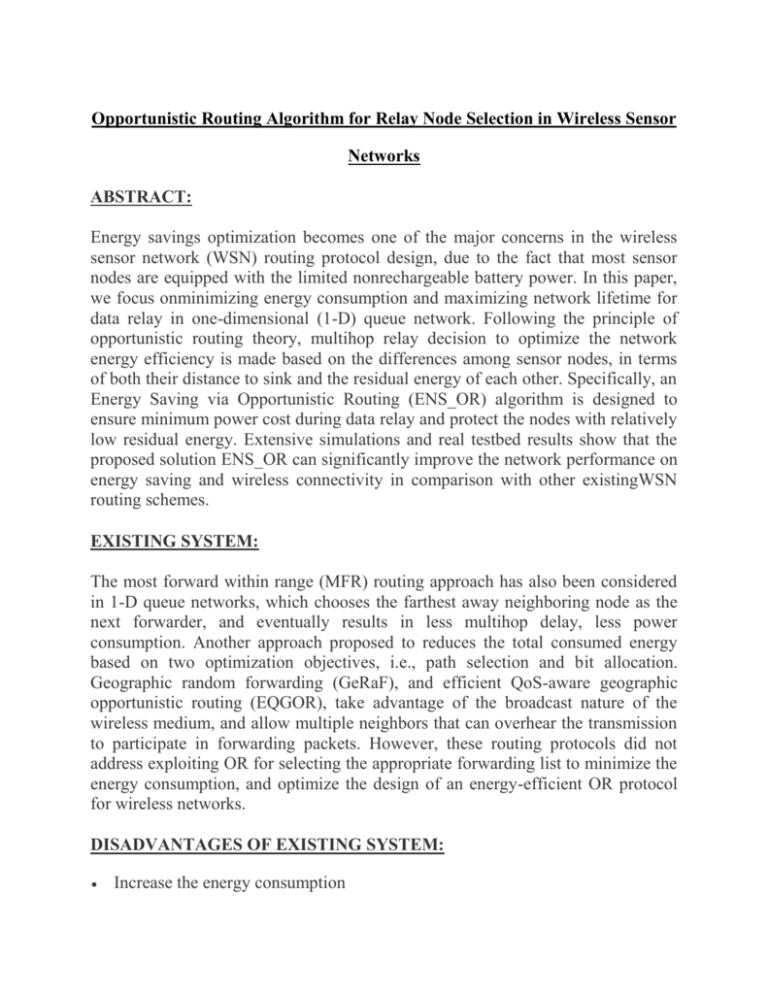
Opportunistic Routing Algorithm for Relay Node Selection in Wireless Sensor Networks ABSTRACT: Energy savings optimization becomes one of the major concerns in the wireless sensor network (WSN) routing protocol design, due to the fact that most sensor nodes are equipped with the limited nonrechargeable battery power. In this paper, we focus onminimizing energy consumption and maximizing network lifetime for data relay in one-dimensional (1-D) queue network. Following the principle of opportunistic routing theory, multihop relay decision to optimize the network energy efficiency is made based on the differences among sensor nodes, in terms of both their distance to sink and the residual energy of each other. Specifically, an Energy Saving via Opportunistic Routing (ENS_OR) algorithm is designed to ensure minimum power cost during data relay and protect the nodes with relatively low residual energy. Extensive simulations and real testbed results show that the proposed solution ENS_OR can significantly improve the network performance on energy saving and wireless connectivity in comparison with other existingWSN routing schemes. EXISTING SYSTEM: The most forward within range (MFR) routing approach has also been considered in 1-D queue networks, which chooses the farthest away neighboring node as the next forwarder, and eventually results in less multihop delay, less power consumption. Another approach proposed to reduces the total consumed energy based on two optimization objectives, i.e., path selection and bit allocation. Geographic random forwarding (GeRaF), and efficient QoS-aware geographic opportunistic routing (EQGOR), take advantage of the broadcast nature of the wireless medium, and allow multiple neighbors that can overhear the transmission to participate in forwarding packets. However, these routing protocols did not address exploiting OR for selecting the appropriate forwarding list to minimize the energy consumption, and optimize the design of an energy-efficient OR protocol for wireless networks. DISADVANTAGES OF EXISTING SYSTEM: Increase the energy consumption Decrease the network lifetime Existing protocols did not address the opportunistic routing PROPOSED SYSTEM: In this project, we propose an energy-efficient routing algorithm for above 1-D queue network, namely, Energy Saving via Opportunistic Routing (ENS_OR). ENS_OR adopts a new concept called energy equivalent node (EEN), which selecting relay nodes based on opportunistic routing theory, to virtually derive the optimal transmission distance for energy saving and maximizing the lifetime of whole network. ENS_OR selects a forwarder set and prioritizes nodes in it, according to their virtual optimal transmission distance and residual energy level. Nodes in this forwarder set that are closer to EENs and have more residual energy than the sender can be selected as forwarder candidates. ADVANTAGES OF PROPOSED SYSTEM: Increase the network lifetime Decrease the energy consumption 12.Effective Key Management in Dynamic Wireless Sensor Networks ABSTRACT: Recently, wireless sensor networks (WSNs) have been deployed for a wide variety of applications, including military sensing and tracking, patient status monitoring, traffic flow monitoring, where sensory devices often move between different locations. Securing data and communications requires suitable encryption key protocols. In this paper, we propose a certificateless-effective key management (CL-EKM) protocol for secure communication in dynamic WSNs characterized by node mobility. The CL-EKM supports efficient key updates when a node leaves or joins a cluster and ensures forward and backward key secrecy. The protocol also supports efficient key revocation for compromised nodes and minimizes the impact of a node compromise on the security of other communication links. A security analysis of our scheme shows that our protocol is effective in defending against various attacks.We implement CL-EKM in Contiki OS and simulate it using Cooja simulator to assess its time, energy, communication, and memory performance. EXISTING SYSTEM: In existing, two-layered key management scheme and a dynamic key update protocol in dynamic WSNs based on the Diffie-Hellman (DH), respectively. However, both schemes are not suited for sensors with limited resources and are unable to perform expensive computations with large key sizes (e.g. at least 1024 bit). Since ECC is computationally more efficient and has a short key length (e.g. 160 bit), several approaches with certificate have been proposed based on ECC. However, since each node must exchange the certificate to establish the pairwise key and verify each other’s certificate before use, the communication and computation overhead increase dramatically. Also, the BS suffers from the overhead of certificate management. Moreover, existing schemes are not secure DISADVANTAGES OF EXISTING SYSTEM: Unable to access with large size of keys Increase the overhead Cannot provide more secure Resolve the key escrow problem PROPOSED SYSTEM: In this paper, we present a certificateless effective key management (CL-EKM) scheme for dynamic WSNs. In certificateless public key cryptography (CL-PKC), the user’s full private key is a combination of a partial private key generated by a key generation center (KGC) and the user’s own secret value. The special organization of the full private/public key pair removes the need for certificates and also resolves the key escrow problem by removing the responsibility for the user’s full private key. We also take the benefit of ECC keys defined on an additive group with a 160bit length as secure as the RSA keys with 1024-bit length. ADVANTAGES OF PROPOSED SYSTEM: Provide more security Decrease the overhead Protects the data confidentiality and integrity
